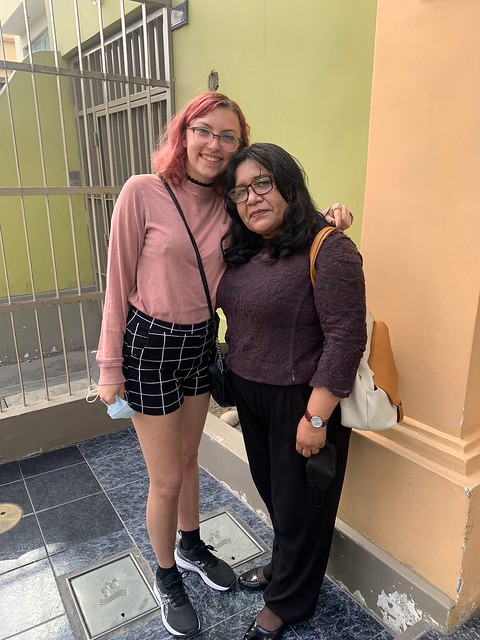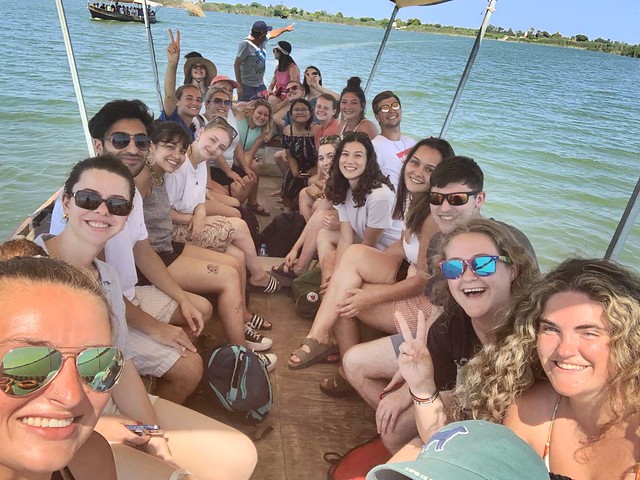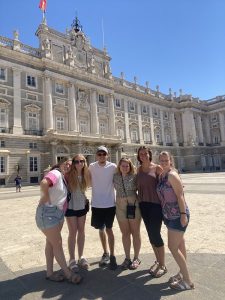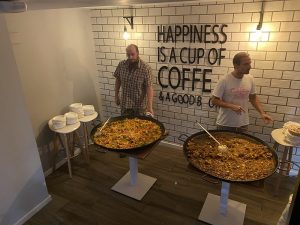A Beautiful Castle, Beach and History of Peñíscola, Spain
On the weekends, Tarjona language school takes some of its students on excursions to see different sites that we may not know about. On July 24th, we got on the 2 hour bus ride and headed to  Peñíscola for the day. On the bus, a few students in our group were able to get to know other students from different countries who were from different Spanish classes. When we finally got there, I was so excited to see the amazing views. When we hopped off the bus we got to see a glimpse of one of the beaches, then started our journey up to the old castle. On our walk, we were able to see the beautiful roads filled with flowers, take pictures of the bright blue water, and pass by many little shops. When we got to the
Peñíscola for the day. On the bus, a few students in our group were able to get to know other students from different countries who were from different Spanish classes. When we finally got there, I was so excited to see the amazing views. When we hopped off the bus we got to see a glimpse of one of the beaches, then started our journey up to the old castle. On our walk, we were able to see the beautiful roads filled with flowers, take pictures of the bright blue water, and pass by many little shops. When we got to the  castle, we were able to see artifacts, the church, and if you went up the skinny steep staircase, then you would have seen the most amazing view of Peñíscola.
castle, we were able to see artifacts, the church, and if you went up the skinny steep staircase, then you would have seen the most amazing view of Peñíscola.
For my Game of Thrones fans out there, you would have noticed that many scenes were filmed here, which was really exciting to see in my opinion! We were able to take some pictures before heading out on our own for lunch or the beach. A lot of the restaurants were overlooking the water! At the end of the day, we all met up for some fun on the beach before getting back on the bus for another 2 hours. I wish we could have stayed longer in this beautiful city!
 We have completed three weeks of language school and almost a month of being away from home. We’ve walked many, many miles – a couple students logged 30,000 steps in one day as they walked the entire riverbed park – La Turia – in Valencia. It’s been very hot as many countries in Europe experienced another heat “storm” and many of the buildings in Valencia have no air conditioning. As we all prepare to reorient ourselves to our families and friends, cooler weather and prepare for what comes next, we invite you to read a few of our final reflections.
We have completed three weeks of language school and almost a month of being away from home. We’ve walked many, many miles – a couple students logged 30,000 steps in one day as they walked the entire riverbed park – La Turia – in Valencia. It’s been very hot as many countries in Europe experienced another heat “storm” and many of the buildings in Valencia have no air conditioning. As we all prepare to reorient ourselves to our families and friends, cooler weather and prepare for what comes next, we invite you to read a few of our final reflections.
– Shania Coleman
Discomfort and Adaptation
Wrapping up cross-cultural this week, I have been reflecting back on things I’ve learned about myself throughout the trip. First, I’ve learned how to be okay being uncomfortable and adapting to a new culture. I feel like traveling is one of the best ways to really grow and learn about yourself because every day is different with new opportunities. Traveling is not going to go smoothly 100% of the time, so learning how to navigate and handle those issues is a big lesson I have learned in Spain. Another thing I learned about myself on this trip is that I need alone time.  I feel like when we are traveling in a big group and we all have roommates, it’s hard to get that alone time and regroup. I didn’t know how much I would need that until I came to Spain. Luckily, we have a great group of people in this cross-cultural group who have an understanding of people’s needs and are self-aware individuals. Overall, this trip has been extremely beneficial to learning more about myself. I think it was important for me to come on this trip and get out of my comfort zone!
I feel like when we are traveling in a big group and we all have roommates, it’s hard to get that alone time and regroup. I didn’t know how much I would need that until I came to Spain. Luckily, we have a great group of people in this cross-cultural group who have an understanding of people’s needs and are self-aware individuals. Overall, this trip has been extremely beneficial to learning more about myself. I think it was important for me to come on this trip and get out of my comfort zone!
– Hannah York
Reflections on Our Experience
I was given the hard task of wrapping up the entire trip into one blog post. When thinking back on this trip there were so many high points that I’m not sure exactly what I want to talk about most. Was it all of the museums, the bullfight, the complex history behind the architecture and the city, or was it something as small as being happy to see clouds in the sky, hearing cracked tile beneath your feet on the walk to school, finally being able to have a conversation in Spanish and understanding what was being talked about, or was it something else underlying that made this trip so exceptional?
Some of the best parts of this trip happened when we all gave into the culture and really tried to understand the similarities and differences between our culture and aspects of Spanish culture – when we weren’t afraid to use our Spanish and grow our vocabulary by talking to local people or when we learned how to navigate city transportation with only a few missed stops.
Being on this cross-cultural has provided every single one of us with opportunities to not only grow the skills we came into Spain with but also to learn new skills like speaking better Spanish, navigating a new city, and learning how to fit into a new culture all while discovering new things about ourselves that we will be able to bring back to the U.S. with us.
If you would have asked me before I left for Spain if I thought requiring cross-cultural was a good thing, I’m not sure what I would have responded with. After being in Spain for nearly a month, I can say with certainty that I will now always say “yes”. Although we were only here for a month, we made thousands of memories and learned priceless skills that will help us as we move into the workforce and back into our home communities. As we start our journey back to EMU, I can say that I am going to miss everything about Spain; its welcoming community, the laid-back culture, and the beautiful architecture are a few things that I can say I will never be able to forget.
– Abby Clayton
Poem
To Sweet Valencia:
Surfing the skies,
Riding the trains,
Walking the streets,
And learning their names.
Welcoming every day faster than last,
Glancing aback at the ghosts of the past,
Learning her customs, her language, her ways,
In the sweltering heat of the sun’s mighty rays.
Her people, her people, are her heart and her soul,
The root of the good, the evil, the whole.
For though we might struggle or draw a poor hand,
Laura can laugh and yet understand,
And in even the darkest and hottest of nights,
Salva’s quick wit fans our spirits alight.
Though within our own group, some choice moments transpired,
And it’s here that I’ll read off some quotes I’ve acquired:
Ladies of the night were often invading,
And biodegradable straws were biodegrading,
Is it potatoes or the Pope that we’re baking?
Does lactose intolerance improve decision-making?
Maybe we listen to Larry the Cable Guy more than we should,
But it’s an established fact, his spit tastes kind of good
Whether being too white to get a tan,
Or milking someone for as long as we can,
As we ready ourselves to fly off to the West,
There’s no doubt our quotes are the best of the best.
For these are the memories,
The new bonds we share,
Forged on the streets
Of that old city fair.
And though we’re eager to come home,
Having appeased EMU’s intelligentsia,
May we all someday return,
To sweet Valencia.
– Isaac Spicher

 g with a host family during my time here in Lima has been one of the most rewarding experiences I have had here in Peru. I live in the district of Chorrillos with my host mom, Mary. My host sister, Luana, lived with us until she traveled to Spain one month ago. My host mom and I enjoy watching movies together, laughing about random things, and talking about our days. We also enjoy going out to eat my favorite Peruvian dish, “lomo saltado”. My host mom has a big heart and has made me feel at home here in Lima. I am going to miss her a lot when I leave Lima next week!
g with a host family during my time here in Lima has been one of the most rewarding experiences I have had here in Peru. I live in the district of Chorrillos with my host mom, Mary. My host sister, Luana, lived with us until she traveled to Spain one month ago. My host mom and I enjoy watching movies together, laughing about random things, and talking about our days. We also enjoy going out to eat my favorite Peruvian dish, “lomo saltado”. My host mom has a big heart and has made me feel at home here in Lima. I am going to miss her a lot when I leave Lima next week!




















